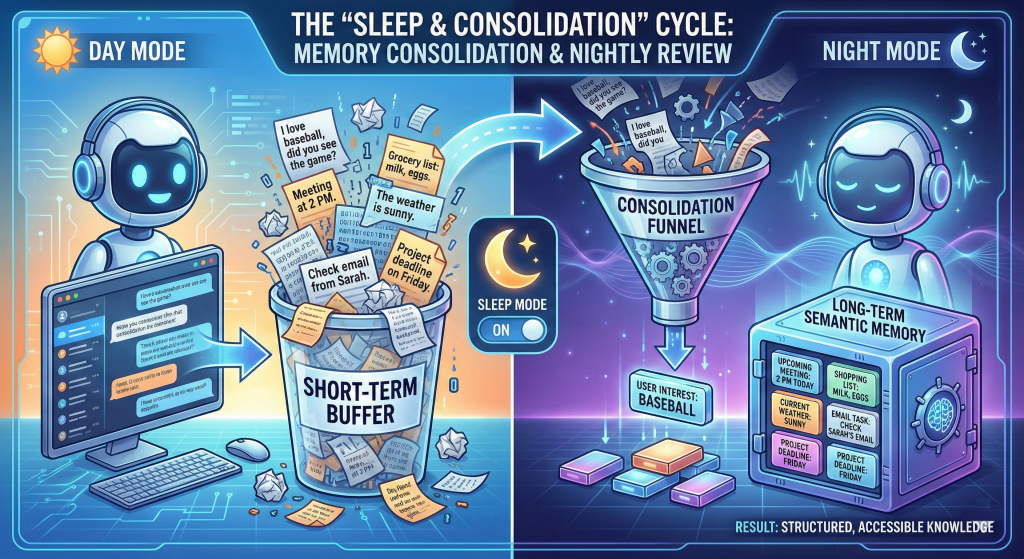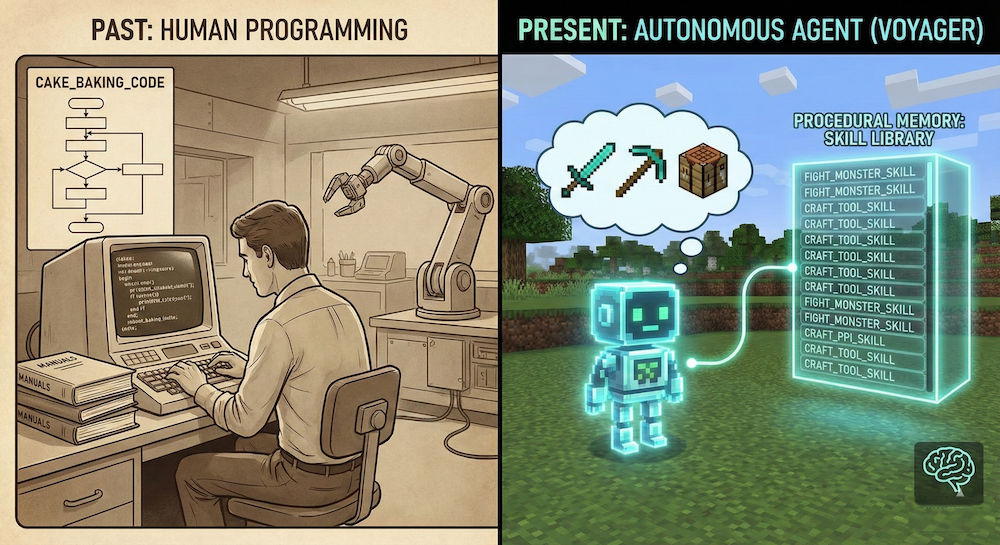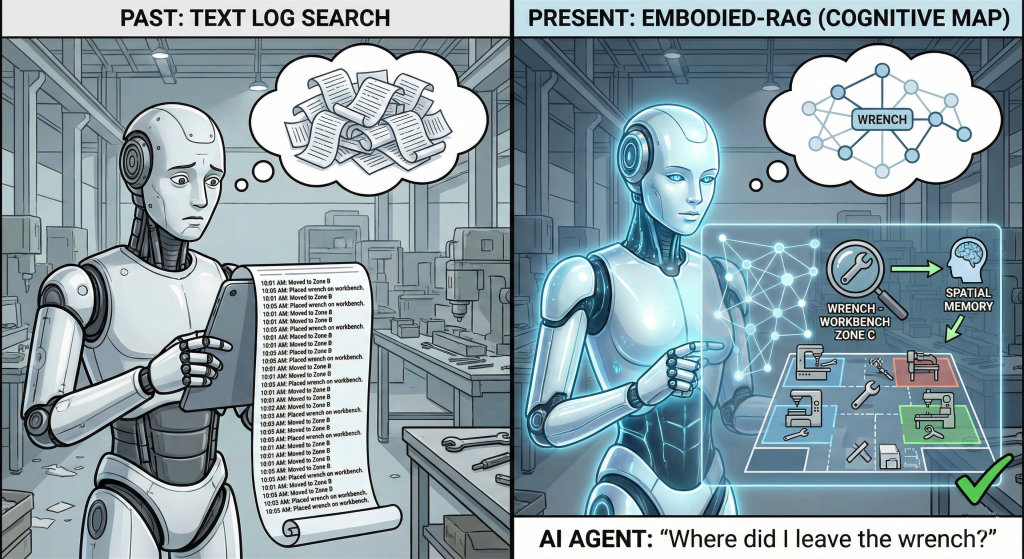In Part 1, we took a tour of the human mind, the flashing sensory foyer, the sticky-note workbench, and the deep vaults of long-term memory.
In Part 2, we saw how scientists are handing robots crude diaries and encyclopedias, trying to patch these tools together to make them remember.
Now, in Part 3, we stop looking at what is and start dreaming about what could be. To build a digital brain that truly mirrors the human mind, we cannot just pile more data into a computer. We need a blueprint. We need architecture.
The Problem: A Jumbled Soup
Right now, most AI models are like a person who has read every book in the world but cannot remember your name or how to tie their shoes. They treat a math problem, a heartfelt confession, and a geography question exactly the same way—as a stream of text tokens.
To fix this, we need to stop treating memory as one big bucket. We need to build a Layered Memory Architecture. Just as you don’t look for your car keys in your high school history textbook, an AI shouldn’t look for your birthday in its training data on quantum physics. It needs to know where to look.
The Problem: A Jumbled Soup
Imagine an AI agent not as a single black box, but as a building with a very smart receptionist at the front desk. We call this receptionist the Memory Manager or the Triage Module.
Here is how the ideal digital brain would handle a conversation:

1. The Intake
You say to the AI: “Last week you helped me plan an exercise routine—what was the schedule? Also, what is the formula for target heart rate, and do you know the address of the gym downtown?”
A standard AI might panic and try to guess. The Digital Brain, however, pauses. The Triage Module breaks this sentence into three distinct tickets:
Here is how the ideal digital brain would handle a conversation:
- “Address of the gym…” (This is a specific location).
- “Last week…” (This is a memory of an event).
- “Formula for heart rate…” (This is a fact or a skill).
2. The Routing
The Triage Module sends runners to three different rooms simultaneously:

- The Diary Room (Episodic Memory): The runner searches the logs of your past conversations. It ignores Wikipedia and focuses only on us. It finds the entry from last Tuesday: “Mon/Wed/Fri cardio at 7 am.”
- The Library (Semantic/Procedural Memory): This runner ignores your personal life and goes to the medical shelf. It pulls a fact: “Target Heart Rate = 220 minus age.”
- The Map Room (Spatial Memory): This runner goes to the graph of locations. It looks for “Downtown Gym” and finds “123 Main Street.”
3. The Synthesis
The runners return to the front desk. The AI doesn’t just paste the answers together; it weaves them into a narrative. It says: “Sure! Last week we decided on cardio Mondays, Wednesdays, and Fridays. The formula you wanted is 220 minus your age, and that gym is at 123 Main Street.”
This is the Hub-and-Spoke model: a central intelligence directing queries to specialized storage units.
Bridging the Gap: From Sci-Fi to Reality
This architecture sounds like common sense, but building it is incredibly hard. However, researchers are already laying the bricks.
The Robot That Sleeps
Humans don’t remember every second of every day. We sleep. During sleep, our brains consolidate memories, moving them from short-term storage to long-term memory.

New AI architectures, like Generative Agents, are attempting to mimic this. Instead of just logging chat history, the agent performs a “nightly review.” It reflects on the day’s events and distills them into higher-level beliefs. If you mention you like baseball three times, the agent doesn’t just store the transcripts; it creates a new Semantic Memory: “The user is a baseball fan.”
The Robot That Learns Skills

In the past, if you wanted a robot to bake a cake, you had to program the code for baking. Now, we are seeing agents like Voyager (in Minecraft) write their own code. When they figure out how to fight a monster or craft a tool, they save that specific skill in a Procedural Memory library. They are building their own “muscle memory” over time, learning without a human updating their software.
The Robot That Makes Maps

For a digital brain to exist in the real world, it needs a sense of “where.” Systems like Embodied-RAG allow an AI to create a “cognitive map”—a graph of places and things it has seen. It allows an agent to answer questions like, “Where did I leave the wrench?” by checking its spatial memory of the factory, rather than reading through a text log.
The Long Road Ahead
We have the blueprint. We know we need a Triage Module, distinct memory rooms, and a way for the AI to “sleep” and consolidate facts. But we are still far from a truly human-like digital brain.
The gap is vast. We need to figure out Adaptive Forgetting—teaching the AI to discard outdated information so it doesn’t get confused. We need to master Multi-modal Memory, linking the image of a person with the conversation you had with them.
But the goal is clear. We are moving away from static chatbots that reset every time you close the window. We are moving toward Adaptive Agents—digital companions that remember your story, learn from your life, and grow alongside you.
It is no longer just about processing speed. It is about building a mind that remembers.
References
- Arya.ai. (n.d.). Why memory matters for AI agents: Insights from Nikolay Penkov. Arya.ai Blog. https://arya.ai/blog/why-memory-matters-for-ai-agents-insights-from-nikolay-penkov
- Fujitsu Research Technology Blog. (2025, March 31). Enhancing AI agent spatial reasoning for real-world applications. fltech – Technology Blog of Fujitsu Research. https://blog-en.fltech.dev/entry/2025/03/31/EmbodiedRAG_YOWO-en
- IBM. (n.d.). What is AI agent memory? https://www.ibm.com/think/topics/ai-agent-memory
- LLM Watch. (n.d.). AI agents of the week: Papers you should know about. https://www.llmwatch.com/p/ai-agents-of-the-week-papers-you-513
- Northwest AI Consulting. (n.d.). What is AI agent memory? Complete guide. https://nwai.co/what-is-ai-agent-memory-complete-guide
- Potluri, N. (n.d.). Semantic vs episodic vs procedural memory in AI agents and why you need all three. Women in Technology (on Medium). https://medium.com/womenintechnology/semantic-vs-episodic-vs-procedural-memory-in-ai-agents-and-why-you-need-all-three-8479cd1c7ba6
- Sareen, S. (n.d.). Giving AI agents memory: Architecting intelligence with context, continuity, and cognition. Medium. https://medium.com/@sonal.sareen/giving-ai-agents-memory-architecting-intelligence-with-context-continuity-and-cognition-351c9a994f04
- Sumers, T. R., Yao, S., Narasimhan, K., & Griffiths, T. L. (2023). Cognitive architectures for language agents. arXiv preprint arXiv:2309.02427. https://ar5iv.labs.arxiv.org/html/2309.02427
- Zhang, H., Zhang, Z., Wang, Z., Zhang, Z., Zhou, Q., Fang, L., & Gan, C. (2025). Ella: Embodied social agents with lifelong memory. arXiv preprint arXiv:2506.24019v1. https://arxiv.org/html/2506.24019v1


